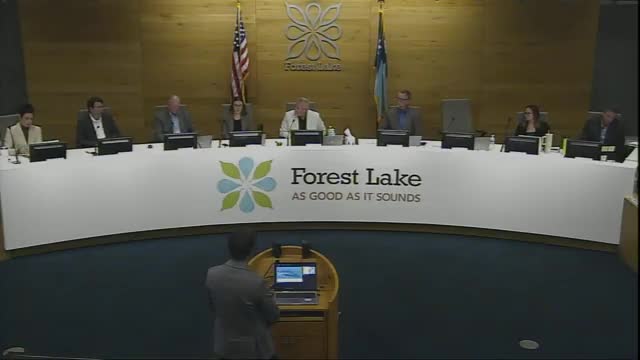Council approves scope and fee for Judicial Ditch 4 corridor project and accepts DNR grant terms
October 13, 2025 | Forest Lake City, Washington County, Minnesota
This article was created by AI summarizing key points discussed. AI makes mistakes, so for full details and context, please refer to the video of the full meeting. Please report any errors so we can fix them. Report an error »

The Forest Lake City Council approved a scope-and-fee proposal from Bolton & Menk and accepted a Minnesota Department of Natural Resources (DNR) grant agreement to study and implement stormwater corridor work along Judicial Ditch 4.
The project seeks to protect and restore low-lying drainage corridors, secure parcels for regional stormwater detention, and integrate wetland restoration and recreational greenway elements. The DNR awarded approximately $5.7 million for the project, with land-acquisition costs estimated at about $5.5 million and approximately $200,000 earmarked for additional design and scoping work, according to consultant Tim Olson of Bolton & Menk.
Why it matters: The corridor work addresses flood control and water-quality issues at the headwaters of the Rice Creek chain-of-lakes watershed. City staff and the consultant said advance work in the corridor will make future development more efficient, reduce downstream flooding risk and improve regional water-quality outcomes. The council approved the Bolton & Menk scope-and-fee work so DNR grant timelines and deliverables can proceed.
Project description and timeline: Bolton & Menk identified three priority areas along Judicial Ditch 4, with the largest opportunity in a middle branch where wetlands can be restored and expanded. The plan calls for further wetland delineation, meetings with Rice Creek Watershed District, property-owner outreach, and an early initiation of the partial-transfer (103E) process required when ditch segments move from agricultural-ditch maintenance to municipal stormwater management. The DNR grant provides a five-year window to complete acquisition and project work.
Voting and next steps: Council moved and seconded a motion to accept the scope-and-fee proposal and the grant agreement; the motion passed unanimously. Bolton & Menk will proceed with extended wetland delineation, property coordination and design tasks; staff will coordinate with Rice Creek Watershed District and pursue acquisition steps under the grant schedule.
Ending: City officials described the project as an opportunity to secure a corridor that will serve both flood-control and recreation roles while leveraging state grant funds to minimize direct city capital outlay.
The project seeks to protect and restore low-lying drainage corridors, secure parcels for regional stormwater detention, and integrate wetland restoration and recreational greenway elements. The DNR awarded approximately $5.7 million for the project, with land-acquisition costs estimated at about $5.5 million and approximately $200,000 earmarked for additional design and scoping work, according to consultant Tim Olson of Bolton & Menk.
Why it matters: The corridor work addresses flood control and water-quality issues at the headwaters of the Rice Creek chain-of-lakes watershed. City staff and the consultant said advance work in the corridor will make future development more efficient, reduce downstream flooding risk and improve regional water-quality outcomes. The council approved the Bolton & Menk scope-and-fee work so DNR grant timelines and deliverables can proceed.
Project description and timeline: Bolton & Menk identified three priority areas along Judicial Ditch 4, with the largest opportunity in a middle branch where wetlands can be restored and expanded. The plan calls for further wetland delineation, meetings with Rice Creek Watershed District, property-owner outreach, and an early initiation of the partial-transfer (103E) process required when ditch segments move from agricultural-ditch maintenance to municipal stormwater management. The DNR grant provides a five-year window to complete acquisition and project work.
Voting and next steps: Council moved and seconded a motion to accept the scope-and-fee proposal and the grant agreement; the motion passed unanimously. Bolton & Menk will proceed with extended wetland delineation, property coordination and design tasks; staff will coordinate with Rice Creek Watershed District and pursue acquisition steps under the grant schedule.
Ending: City officials described the project as an opportunity to secure a corridor that will serve both flood-control and recreation roles while leveraging state grant funds to minimize direct city capital outlay.
View the Full Meeting & All Its Details
This article offers just a summary. Unlock complete video, transcripts, and insights as a Founder Member.
✓
Watch full, unedited meeting videos
✓
Search every word spoken in unlimited transcripts
✓
AI summaries & real-time alerts (all government levels)
✓
Permanent access to expanding government content
30-day money-back guarantee

